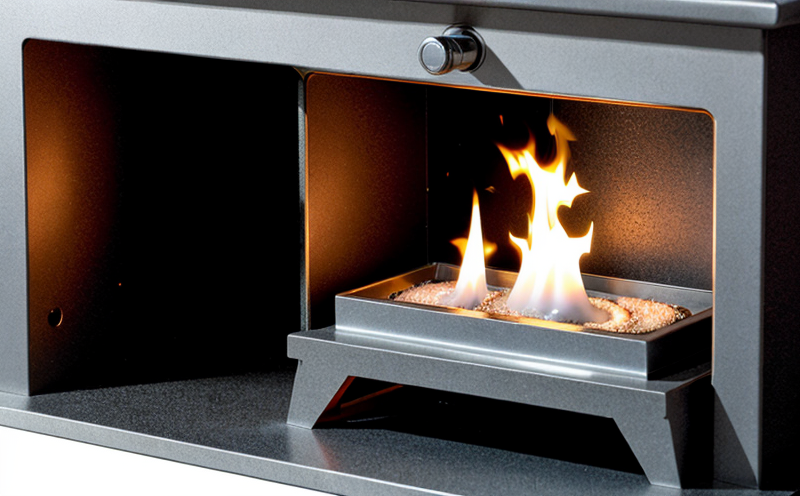Surface Flame Spread Testing of Cladding Materials
The evaluation of cladding materials through surface flame spread testing is critical in ensuring fire safety standards are met. This test assesses how a material behaves when exposed to ignition, specifically measuring the rate at which it propagates over its surface. The outcomes of this testing determine whether the material meets regulatory requirements for fire resistance and ignitability.
Cladding materials are used extensively in construction to enhance aesthetics, insulate buildings, and provide additional protection against environmental elements. However, their installation near combustible surfaces can increase the risk of fire spread. Surface flame spread testing provides a standardized method to quantify this risk, ensuring that cladding products contribute positively rather than negatively to fire safety.
The testing process involves exposing a sample of the material to controlled conditions in a specialized chamber. The rate at which the flame spreads along the surface is measured and compared against specified limits defined by relevant standards such as ASTM E84 or ISO 6702. Compliance with these standards ensures that materials meet strict fire safety requirements.
Understanding the implications of this testing for different sectors is essential. For instance, in commercial buildings, compliance with local codes can prevent costly delays during construction and ensure ongoing safety for occupants. In industrial settings, non-compliance could result in fines or even legal action. This underscores why accurate surface flame spread testing is not just a guideline but an absolute necessity.
Proper preparation of the test specimen is crucial to obtaining reliable results. The sample must be cut according to specified dimensions and mounted on a standard frame within the chamber. The material’s orientation should also follow prescribed guidelines to ensure consistent conditions during testing. Once prepared, the sample undergoes exposure to the flame source for a defined period.
The apparatus used in these tests includes a specialized chamber designed to control airflow, heat transfer, and flame propagation. This setup allows precise measurement of the rate at which flames spread across the material surface. The results are then analyzed using sophisticated software that calculates the flame spread index (FSI) or smoke developed value (SDV), depending on the standard being followed.
Accurate reporting is another critical aspect of this testing service. Detailed reports outline all test parameters, specimen preparation steps, and final results. These documents serve as a reference for developers, architects, and other stakeholders involved in project compliance. They also provide valuable insights into material performance under controlled fire conditions, helping to inform future product improvements.
In summary, surface flame spread testing plays an indispensable role in validating the fire safety characteristics of cladding materials. By adhering to rigorous standards and procedures, this service ensures that construction products contribute positively to overall building safety without compromising design or functionality.
Why It Matters
The importance of surface flame spread testing cannot be overstated in today’s increasingly complex construction industry. Regulatory bodies worldwide have implemented stringent fire safety codes and standards aimed at reducing the risk of fires and minimizing their impact on human life and property.
In commercial buildings, for example, any non-compliance with these regulations can lead to severe consequences such as project delays, costly rework, or even legal action. Furthermore, in high-risk environments like hospitals or schools, fire safety is paramount. Non-compliant materials could exacerbate the situation during emergencies, making it imperative that all building components adhere strictly to prescribed standards.
From a broader perspective, ensuring compliance with international norms such as ASTM E84 and ISO 6702 fosters trust among stakeholders including architects, engineers, developers, and end-users. It also promotes best practices in fire safety engineering, contributing significantly to public confidence and safety.
In essence, surface flame spread testing is more than just a compliance requirement; it represents a commitment to enhancing the overall safety of built environments. By incorporating this service into their quality assurance processes, organizations demonstrate their dedication to upholding high standards of integrity and responsibility.
Benefits
- Ensures compliance with international fire safety regulations such as ASTM E84 and ISO 6702.
- Promotes safer buildings by validating the flame spread characteristics of cladding materials.
- Aids in meeting project deadlines by identifying potential issues early in the development process.
- Provides valuable data that can be used to improve product design and performance.
- Enhances stakeholder trust through transparent reporting practices aligned with recognized standards.
- Reduces risks associated with non-compliance, thereby minimizing financial penalties and legal liabilities.
Industry Applications
| Application | Description |
|---|---|
| Hospital Buildings | Ensures that cladding materials used in hospitals meet strict fire safety standards to protect patients and staff. |
| Shopping Centers | Reduces risks associated with potential fires, protecting shoppers and ensuring business continuity. |
| Office Spaces | Provides peace of mind for tenants knowing that building materials comply with fire safety regulations. |
| Residential Properties | Makes homes safer by validating the performance of cladding materials in case of a fire emergency. |





